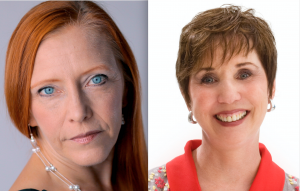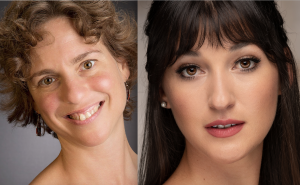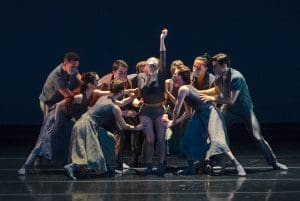The common perception that the dance world is controlled chiefly by men might be partly true, but the situation in Kansas City presents a noticeably different landscape. Consider this: Of the dozen works of choreography being performed this spring by the four most prominent local companies, only two are by men.

Mona Störling-Enna; Mary Pat Henry (Mutrux Photography)
And while this hardly means that dance has achieved gender equity across the land, it speaks well for our own community. (It’s worth noting that the situation in classical ballet, both locally and nationally, is more complex than that in modern and contemporary dance.)
In February, Wylliams/Henry Contemporary Dance Company presented works by Co-artistic Directors Mary Pat Henry and DeeAnna Hiett, in an innovative collaboration with the all-female Bach Aria Soloists.

Jennifer Owen; Emily Mistretta (Brett Pruitt & East Market Studios)
This year, for the first time, the Kansas City Ballet populated its New Moves program entirely with works by women choreographers (March 24th to 27th): Three guest artists and six Main Company and Second Company members created seven new ballets for this annual favorite.
On April 1st through the 3rd, the Owen/Cox Dance Group presents the world premiere of Founding Artistic Director Jennifer Owen’s Skin, a collaboration with Singer-songwriter-cellist Helen Gillet.
And on May 13th and 14th, the Störling Dance Theater presents the premiere of Artistic Director Mona Störling-Enna’s Book of Kells, based on a story of faith, artistry, and intrigue during the Middle Ages.

Störling Dance Theater’s Underground / Photo by Kara Holdman
“I feel optimistic about dance here,” said Mona, who co-founded, with her husband, Jeremiah Enna, her Olathe-based company in 1996.
Among Mona’s creations are several remarkable works highlighting historical women: The Prodigal Daughter is a riff on the Biblical tale that ponders how that story might have played out if the runaway had been a girl, and Underground is an evocative treatment of the Underground Railroad that has been seen by tens of thousands since its premiere in 2007.
Kansas City women are “leading with vision and hope and positive leadership,” Jeremiah said, having “started companies out of their own inspiration…”

Since founding her company with her husband, Brad Cox, Jennifer Owen has created some 50 works of choreography, large and small.
All these groups were built on strong foundations: Störling Dance is celebrating its 25th anniversary, Wylliams/Henry recently marked 30 years, and Owen/Cox marks its 15th season this year.
“I never thought that my being female would be a barrier for me,” said Jennifer Owen, who had a successful career as a ballet dancer (including several years with Kansas City Ballet) before founding the company in 2007 with her husband, Brad Cox.
Jennifer started as a youngster, transforming slumber parties with dancer friends into choreographic work-sessions, until one day her father predicted: “You’re going to have your own dance company one day.”
But she wanted to be a prima ballerina first, and when her company finally did become a reality “the barriers were fundraising and resources,” she said, and had little to do with her being a woman. She still finds that having her own company “is a wonderful platform with which to create.” (Jennifer has choreographed some 50 works, including several ambitious full-length pieces.)

Wylliams/Henry Contemporary Dance Company was formed in 1991 by Mary Pat Henry and the late Leni Wylliams.
No one knows the differences between the modern and ballet worlds better than Jennifer: namely, the idea that classical ballet with its focus on a patriarchic “canon” of classics by men has been slower to achieve gender equity.
“The ballerina has very little autonomy, unless you are very famous,” Jennifer said, adding that in America not only is the main repertory still by men, but that ballet dancers “still get a year-by-year contract: There’s no stability.”
The submissive role of women, moreover, goes back to classical ballet’s earliest days. “It’s a historical form that stems from Louis XIV,” Jennifer said, “with the ballerina always being in a position of servitude.”
But because of such pioneers as Isadora Duncan, Martha Graham, Katherine Dunham, Doris Humphrey, and Ruth St. Denis, women in modern and contemporary dance had a bit of a head start from the outset.

Katlyn Addison was promoted to principal dancer at Ballet West in 2021. / Photo by Beau Pearson
“The modern world started with so much female leadership, and that had an immediate impact,” Mona said. “Whereas the ballet world is hundreds of years old and was started by men.”
Still, those who are thriving in ballet are not ready to declare it incapable of telling modern, or full-length, stories. Indeed, what is to stop women from creating their own versions of Swan Lake, Giselle, or The Sleeping Beauty? “I think there will be reinterpretation of those pieces,” said Devon Carney, Kansas City Ballet’s artistic director. “They’ll always happen, but maybe not in the same way.”
The number of women creating new ballets has increased dramatically in the last 20 years, and women are making headway in leadership roles as well. After three centuries of male domination of the field, some of the most interesting choreographers today are Lila York, Helen Pickett, Jennifer Archibald, Twyla Tharp, Crystal Pite, Cathy Marston, Jessica Lang, Annabelle Lopez Ochoa, Aszure Barton, and Hope Muir, to name a few.

Emily Mistretta choreographed Looking for Perilune, performed at Starlight Theatre in July 2021 / Photo by Brett Pruitt & East Market Studios
“We all bring the nuance of our own personal experience,” said Katlyn Addison, a principal dancer at Ballet West who is creating a work for New Moves. “As a dancer, choreographer, and just as a Black woman I will bring something different, and my own experiences in life will show through in the dance.”
Katlyn wants to continue choreographing, “to have my work exposed so that hopefully other companies will want to have me create for them.” She feels she has begun to know what she wants to “say” in dance, “but I know I have to create a lot more, to build on this, so that I really do know my voice.”
As opportunities for women creators become more common around the nation, it often takes but a gentle nudge to get dancers to try their hand at creating.
“I had been drawn to choreographing for a while,” said Emily Mistretta, who joined Kansas City Ballet in 2016. It’s daunting, at first, to realize it’s up to you “to make it into a piece that makes sense, translate that to the dancers, and be in charge of the room,” she said.

Lila York’s Celts / Photo by Kenny Johnson
“All of those things were unknown to me at the beginning.” By now Emily has created half a dozen works, including Looking for Perilune produced last summer, and she is represented on this year’s New Moves as well. “It’s just a raw, open art that we do,” she said. “And being a choreographer, it’s even more so, because it’s all your thought, all your ideas.”
Women are fairly well represented in modern companies, but still lag in ballet leadership. Currently they form 29 percent of the artistic directors at the top 50 American ballet companies, according to statistics from Dance Data Projects. Yet three out of the seven new artistic directors named for 2022 and beyond are women, an encouraging 43 percent.
Making this year’s New Moves an all-female affair “was a very conscious decision,” Devon said. “Because there aren’t enough opportunities for women to create.” Female choreographers “need to be encouraged, lifted up, and celebrated, so they can see their potential to explore the field even further. … They don’t just appear, they need to be nurtured.”
—By Paul Horsley
For tickets, go to kcballet.org, owencoxdance.org, storlingdance.org, and wylliams-henry.org.
To reach Paul Horsley, performing arts editor; send an email to paul@kcindependent.com or find him on Facebook (paul.horsley.501) or Twitter/Instagram (@phorsleycritic).